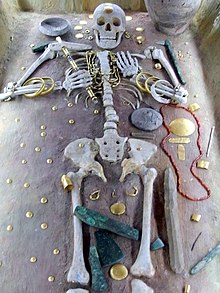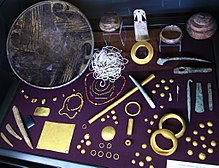Varna culture
Chalcolithic | |
|---|---|
| Dates | c. 4550 BC – c. 4,100 BC |
| Type site | Varna Necropolis, Solnitsata, Durankulak |
| Preceded by | Karanovo culture, Hamangia culture, Gumelnița culture |
| Followed by | Cernavodă culture |

The Varna culture was a Chalcolithic culture of northeastern Bulgaria, dated c. 4500 BC,[1][2] contemporary and closely related with the Gumelnița culture. The oldest golden artifacts in the world (4600 BC - 4200 BC) were found in the Necropolis of Varna. These artefacts are on display in the Varna Archaeological Museum[3][4][5]
The site was accidentally discovered in October 1972 by excavator operator Raycho Marinov. Research excavation was under the direction of Mihail Lazarov and Ivan Ivanov. About 30% of the estimated necropolis area is still not excavated.[citation needed]
The Varna culture is characterized by polychrome pottery and rich cemeteries, the most famous of which are
The oldest gold
The findings showed that the Varna culture had trade relations with distant lands, possibly including the
Burial rites

"Varna is the oldest cemetery yet found where humans were buried with abundant golden ornaments. … The weight and the number of gold finds in the Varna cemetery exceeds by several times the combined weight and number of all of the gold artifacts found in all excavated sites of the same millenium, 5000-4000 BC, from all over the world, including Mesopotamia and Egypt. … Three graves contained gold objects that together accounted for more than half of the total weight of all gold grave goods yielded by the cemetery. A scepter, symbol of a supreme secular or religious authority, was discovered in each of these three graves." (Slavchev 2010)[10]
Religion
The Varna culture had sophisticated religious beliefs about the afterlife and developed hierarchical status differences. It has the oldest known burial evidence of an elite male (Grave 43). Some authors have described the Varna elite males as 'kings'.[11][12] The end of the fifth millennium BC is the time that Marija Gimbutas, founder of the Kurgan hypothesis claims the cultural advance to male dominance began in Europe. The high status male was buried with remarkable amounts of gold, held a war axe or mace and wore a gold penis sheath or possibly a decorative (gold) belt tip. The bull-shaped gold platelets perhaps also venerated virility, instinctive force, warfare and a proto-castle cult.
Genetics
The elite male from Grave 43 (c. 4495 BC) belonged to the paternal (Y-DNA) haplogroup T-M184 and the maternal (mtDNA) haplogroup U2.[13][14] Other male samples from the Varna necropolis belonged to the Y-DNA haplogroups I2a1, I2a2, G2a, T1a, E1b1b and R1b-V88.[15][14]
Gallery
-
Durankulak, Bulgaria[16]
-
Site of the Solnitsata walled settlement
See also
| Chalcolithic Eneolithic, Aeneolithic, or Copper Age |
|---|
|
↑ Stone Age ↑ Neolithic |
|
↓ Bronze Age ↓ Iron Age |
- Early European Farmers
- Old Europe (archaeology)
- Boian culture
- Butmir Culture
- Cucuteni–Trypillia culture
- Funnelbeaker culture
- Hamangia culture
- Karanovo culture
- Gumelnița culture
- Lengyel culture
- Linear Pottery culture
- Sesklo culture
- Solnitsata
- Starčevo culture
- Tisza culture
- Vinča culture
- Old European script
- Carnac Stones - Tumuli
References
- ISBN 978-0-19-973578-5.
- ISBN 978-1-78570-654-7.
- ^ [1] Archived 2022-11-01 at the Wayback Machine Gems and Gemstones: Timeless Natural Beauty of the Mineral World, By Lance Grande
- ^ (https://www.smithsonianmag.com/travel/varna-bulgaria-gold-graves-social-hierarchy-prehistoric-archaelogy-smithsonian-journeys-travel-quarterly-180958733/)
- ^ (https://www.smithsonianmag.com/smart-news/oldest-gold-object-unearthed-bulgaria-180960093/)
- ^ [2] Archived 2022-11-01 at the Wayback Machine Gems and Gemstones: Timeless Natural Beauty of the Mineral World, By Lance Grande
- ^ "Archaeologists have discovered the oldest treasure in the world - Afrinik". 15 May 2021.
- .
This paper discusses the invention of gold metallurgy within the Southeast European Chalcolithic on the basis of newly investigated gold objects from the Varna I cemetery (4550-4450 cal. bc). Comprehensive analyses, including preceding gold finds, shed new light not only on the technical expertise of the so far earliest known fine metalworkers, but also on the general context and potential prerequisites in which the invention of gold metallurgy may be embedded. Here, these structural trajectories as well as the unprecedented inventions connected to this early gold working will be highlighted in order to contextualize the apparently sudden appearance and rapid development of this new craft.
- ^ Miljana Radivojević; Benjamin W. Roberts (2021): 'Balkan metallurgy in a Eurasian context' in Miljana Radivojević; Benjamin W. Roberts; Miroslav Marić; Julka Kuzmanović Cvetković; Thilo Rehren The Rise of Metallurgy in Eurasia. Evolution, Organisation and Consumption of Early Metal in the Balkans, Archaeopress Archaeology, p. 613
- ISBN 9780691143880.
- ^ "The Lost World of Old Europe: The Danube vallery, 5000-3500 BC, exhibition video (Museum of Cycladic Art, Athens, 2010)". YouTube.
- ISBN 978-1-78570-654-7.
- ^ "T-M184 - Varna 43". Family Tree DNA. 2024.
- ^ PMID 29466330.
- PMID 37468624.
- ^ Vajsov, Ivan; et al. (2023). "Durankulak. The door to civilization (Presentation, Kavarna 29.08.2023). From the 5th millennium BC to the 10th century AD".
Further reading
- Henrieta Todorova, The eneolithic period in Bulgaria in the fifth millennium B.C. Oxford : British Archaeological Reports, 1978. BAR supplementary series 49.
- Henrieta Todorova, Kupferzeitliche Siedlungen in Nordostbulgarien. München: Beck 1982. Materialien zur allgemeinen und vergleichenden Archäologie 13.
External links
- Varna Archaeological Museum.
- Varna Necropolis Cultural Tourism page on the Golden Sands Resort web site.
- Another photo by Ivo Hadjimishev
- The Durankulak Lake Town - Kibela's Temple (Древното селище при Дуранкулашкото езеро - Езерният град)
- Very detailed information about findings in Varna necropolis I and II (founded in 1972 and 1976) - in Bulgarian language















![Durankulak, Bulgaria[16]](http://upload.wikimedia.org/wikipedia/commons/thumb/2/2e/Durankulak-Golemija_ostrov.JPG/120px-Durankulak-Golemija_ostrov.JPG)
